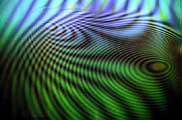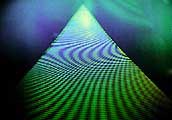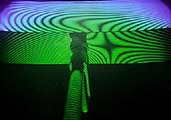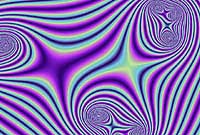THE ART OF INTERFEROMETRY:
Holographic Interferometry is a way of creating 'visual music' frozen in time (by the hologram). The artist applies controlled stress to an object, with his 'technique' of choice (clamps, screws, weights, heat) in producing the desired deformations to his 'instrument' (stainless steel plate, or other subjects). This scientific tool (e.g. for measuring deformities in metal) is for artists a means to express and explore the 'invisible' (to our eyes) forms which occur when material is put under stress or subject to deformities over time. The resulting 'fractal-like' interference ribbon-wavefronts, visualized in a superimposition of two moments in time (before/after), can be viewed either by comparing the first (exposed/developed) hologram against the second (deformed or at rest) state or by double exposing two states 'in time' and viewing the final interferogram-hologram.
Al Razutis (your host) has produced (since the 70's) works featuring interferometric studies of stainless steel sheets, aluminum channels and various materials that are stressed and deformed and then 'relaxed' to produce the (present / afterwards) superimpositions of wavefronts reflected from the metal surfaces. It is the spatial 'wavefronts' that are the main focus of his creations from the selected materials and surfaces. These ribbon-like dark and light patterns provide a visual 'dimension' for the material that is the 'subject' of these interferometric holograms, which he has exhibited as the series 'Stress Topography'.
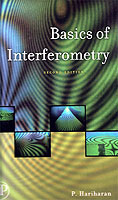 'Stress Topography' a classic suite of 1983-1985 interferograms as art by Al Razutis, was featured on the cover of the book 'Basics of Interferometry' (2nd edition 2006) by P. Hariharan, published by Academic Press. For pictures/descriptions of original interferometric holograms by Razutis visit: ''Stress Topography' page. |
TERMS and CONCEPTS:
Holographic Interferometry is a method of creating holographic 'contour' patterns (wave disturbances 'in time'), typically as a superimposition of two moments ('before' and 'after' disturbance) and is found uniquely in holographic art, and more commonly in 'non destructive testing' in technical quality control (for example, testing wing structure integrity, tire integrity, etc.).
Interferometry records and displays the wave nature of light subject to diffraction and interference. It is a beautiful reminder that we live in a world of energy interfering, diffracting and recombining to shifting patterns and contours of light.
In holographic art interferometry is a process of creating ribbon-like contour mappings and textures in objects or seemingly translucent media (water, air, glass, etc.) by the direct introduction (by the artist) of deformations or by making recordings at certain points of a changing state. Simply stated, the aesthetics of interferometric holograms as art are compositions of light interference that are more akin to the creation of 'musical chords of light' (which displays wave characteristics) than the study of fluid dynamics or 'stress measurements'. It isn't about old Pythagorean (new age) 'music of the spheres' but about the 'music of light' all around us.
In Scientific measurements/tests, interferometry is used to reveal resonance patterns, properties of elasticity, stress, deformations in materials or media, and it is used in technical-industrial evaluations of structures, integrity of materials, hidden flaws in manufacturing, etc. And it got Michaelson and Moreley a Nobel prize for 'measuring the speed of light' and while inventing their interferometer, advancing our knowledge of the electro-magnetic wave nature of light.
Is it Science or is it Art?, asked Alice on her way to the 'Royal Holographic Gallery'....
This page description will feature a basic technical introduction to this art, and some example pieces: the creations of 'visual disturbances in time' as aesthetic works by Razutis, created independently and not for Boeing or any tech or theme-park client.
Time-average Holographic Interferometry: Definitions and Process
Optics definition:
"The study of holograms of a vibrating surface which have been averaged over time; illumination of such a hologram yields an image of the surface on which are superimposed interference fringes which are contour lines of equal displacement of the surface, enabling vibrational amplitudes of the surface to be measured with precision." (McGraw-Hill Dictionary of Scientific & Technical Terms, 2003)
In the artist's Visual Music terms:
"I proceed in the creation of dynamic contour lines of superimposed interference fringes by superimposing two states of a three dimensional object: one at relative rest, and the second with mechanical stress/deformation applied to selected points on its surface. To me, it's like tuning a 'string instrument' to produce a desired visual 'disonance' (or 'chord'). The superimposing interference fringes from these two separate points in 'time' and 'state' form controlled yet maleable contour lines arising from the surface of the object." (Al Razutis, 2010)
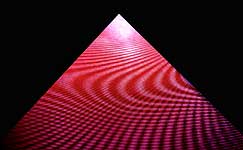
In holographic interferometry (hologram as interferogram), one measures and records the 'phase relatioship' between two co-incident wavefronts of energy (e.g. visible light) which are of the same frequency (wavelength). This measurement relies on interference between coherent waves that results in regions of enhanced signal (constructive interference) when the waves are in phase and regions of no signal (destructive interference) when the waves are exactly out of phase.
To create a superimposition of two disturbances in time a recording is made where a 'reference wavefront' (produced by a laser) is measured against a combination of two mutually interfering 'object' waves (reflections or moduations through a medium) that are taken in successive intervals. These interfering 'wavefronts or disturbances' produce a series of light and dark fringes or 'contour lines'. The record of the fringe pattern is called an interferogram. These separate disturbances are superimposed on the hologram. Separation is achieved by applying a disturbance either to the recording hologram or the subject matter (used in these works) and recording the 'before' (disturbance) and 'after' (disturbrance) as a superimposition of 'states'. In simple terms, one first the records an object, then applies a sected tension or stress to the object with the intention of creating a pattern of interference (between the two states).
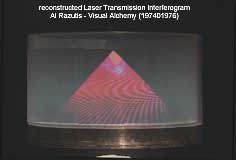
The metalic subjects for the white-light rainbow 1983 'Stress Topography Series' holograms were based on laser transmission interferograms created by Razutis in the 70's. In both cases physical stress was applied (by hand) to specific points resulting in 'deformations' which 'map' the point of stress (eg. concentric circles appearing around the point) in ribbons projected into space.
Basically, one creates a interferogram, by 'double-exposing' a illuminated scene, and recording this superimposition of 'before and after' states (of disturbance) on a holographic plate (as a hologram), using a standard object-reference beam configuration. Further than simply being a 'holographic recording' of a object/scene, the interferometric hologram contains information that is specific to changes occuring in a material-substrate-medium over time.
These interferograms are recordings of a 'disturbance across time', where the disturbance (the change between the two moments) is graphically displayed as the subject matter of the composition (as patterns in three dimensional space).
In the art works depicted in the gallery section on STRESS TOPOGRAPHY, the intent is to explore the manner in which art forms can be created from these 'interventions'. The resulting 'contour patterns' become the expression of what appears to be a 'music-like interplay' between interfering wavefronts. In the hands of a skilled artists, these contour patterns become maleable, controllable creations which resemble 'energy patterns' in space (as distinct from the depiction of 'objects in space').
Critical misunderstandings
An example of the inabilities of art critics to comprehend 'what they were looking at', and therefore coming to uninformed (or idiotic) conclusions about the work is exemplified in the case of Razutis' 1987 exhibition ('The Classic Suite and other stories...') at Simon Fraser University gallery of interferometric works (seen pictured here, and internationally exhibited), and this 'misunderstanding' is instructive for artists and critics alike.
In 1987, a relatively novice art critic for the The Province (Vancouver), Anne Roseberg, described the white light interferogram holograms 'Field', 'Wedge', 'Channel', and others by Razutis as 'psychedellic in color' 'gee gaws' (and otherwise failed expriments in what she refered to as 'holographs'), things that she had no idea about, but immediate negative disposition for (because they looked strange). Her published insults displayed no interest in, or knowledge of, 'what she was looking at', and professed criticism of the interferogram art on the basis of comparisons to 'phychedellic' works (idiotic assertions, at best).
Many shows of holographic art during the 70's - 70's featured 'technical explanations' pasted to the walls: 'what is a hologram', 'how to make a hologram', etc. It was presumed that the audience had 'no idea' of what they were looking at, and the technical descriptions were attempts at fixing this problem. Unfortunately, with a lack of critical theory and insight into the many forms of holography, art critics remain largely ignorant of these subjects and techniques.
CONCEPTUAL RELATIONSHIPS:
...understood by Alice, but misunderstood by the CATERPILLAR
 "FIELD" (1984), a multi-colored white-light transmission interferogram
"FIELD" (1984), a multi-colored white-light transmission interferogram
from multiple stress points occuring on a stainless steel plate.
Produced at Fringe Research, Toronto, with the assistance of Michael Sowdon/Alan Tate.
FIELD is one element of a series titled: "STRESS TOPOGRAPHY".
Computer-generated image of a Julia FRACTAL which resembles contour lines found in topographical mappings and interferograms... FRACTALS are iterations - calculations involving the imaginary number; INTERFEROGRAMS depict near-invisible disturbances of matter in time. According to Alice, the relationship 'is not accidental'.
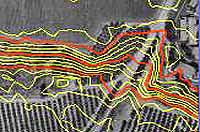
CONTOUR MAPPING from aerial photograph of landscape detail with digital elevation model (DEM) lines superimposed over photo.
Contour lines correspond to land elevation,
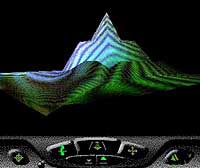
Incorporating via texture map images of hologram into VRML virtual worlds - click for VRML 2.0 world - requires VRML browser plug-in (downloadable)
"FIELDSQUARE WORLD" , A VRML 2.0 world with hologram-interferogram texture maps of elevation grids and objects.
This world combines the fractal and holographic metaphors in a spatial VR depiction.
Produced by Razutis at the Banff Centre, Alberta (1997), as component of UROBOROS VRML 2.0
RELATED SUBJECTS IN ART:
- Holographic-Hybrid Art
- 'Holographic Intentions' at Visual Alchemy
- 'Detailed History' (Visual Alchemy)
- Video: West-Coast Artists in Light
- Display Holography: 'Is it Science? Is it Art?
Sculptural work that combines holography with assemblage
Summary of early works, aesthetics, examples
Visual Alchemy chronology - specific credits; Caterpillar's 'Trick Question'
A videotape survey of 11 artists and their work
Alice visits the Royal Holographic Art Gallery
[Top of Page]
